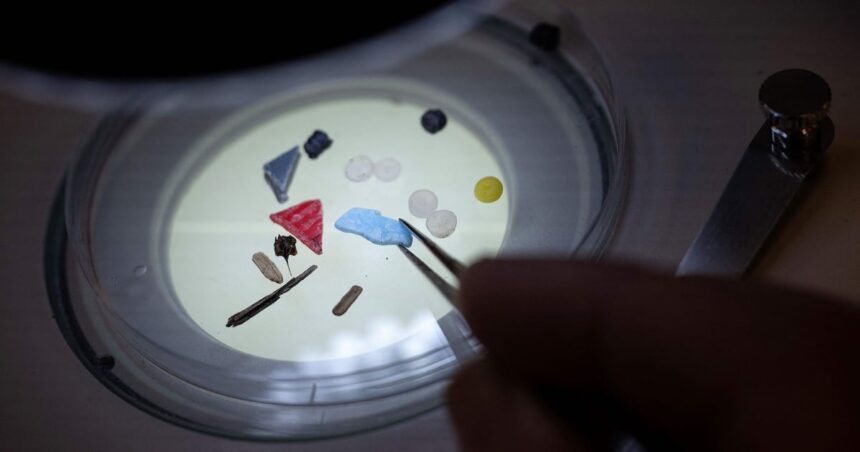I stood in Dr. Maya Reyes’ laboratory at Vancouver General Hospital, watching as she carefully prepared a sample under a specialized microscope. The blue-tinged light cast shadows across her face as she looked up with concern.
“There,” she said, pointing to the screen displaying a magnified image of human follicular fluid. “Those bright specs shouldn’t be there.”
What we were looking at were microplastics—tiny fragments smaller than 5mm—floating in reproductive fluid collected from a volunteer participant in her groundbreaking study. The discovery wasn’t just alarming; it represented a new frontier in our understanding of how deeply environmental contamination has penetrated our bodies.
New research published last week in the Canadian Medical Association Journal reveals that microplastics have been detected in human semen and follicular fluid, raising urgent questions about potential impacts on fertility and reproductive health. The study, conducted across three Canadian provinces, found that 84% of male participants had detectable levels of microplastics in their semen, while follicular fluid samples from women undergoing fertility treatments showed contamination in 73% of cases.
“We’re essentially conducting an uncontrolled experiment on human reproduction,” explains Dr. Reyes, lead author and reproductive endocrinologist. “These materials were never meant to enter our bodies, let alone our reproductive systems.”
The most commonly detected polymers included polyethylene terephthalate (PET)—found in water bottles and food packaging—and polypropylene, which is used in everything from yogurt containers to medical devices. Perhaps most concerning was the presence of bisphenol A (BPA), a known endocrine disruptor.
Walking along English Bay the next morning, I counted seven discarded plastic bottles in just a hundred-meter stretch. Each would eventually break down into thousands of microparticles, continuing their journey through our waterways, soil, air, and ultimately, our bodies.
These findings hit particularly close to home for communities in British Columbia, where recycling programs are strong but plastic pollution persists. Local environmental engineer Samantha Wong from the Pacific Water Research Institute points out that conventional water treatment plants weren’t designed to filter out these microscopic particles.
“Municipal treatment facilities can remove larger plastics, but microplastics often slip through,” Wong told me during a tour of Vancouver’s water management facility. “Once they enter our waterways, they’re virtually impossible to remove.”
The human implications extend beyond Vancouver. In Tofino, I met with James Williams, a member of the Tla-o-qui-aht First Nation, who expressed concern about how these findings affect communities reliant on seafood.
“Our people have harvested from these waters for thousands of years,” Williams said as we looked out at the Pacific. “Now we’re pulling up fish and shellfish contaminated with the waste products of a society built on disposability.”
His concerns are backed by science. Research from Environment and Climate Change Canada indicates that microplastics are pervasive in marine ecosystems, with higher concentrations found near urban centers. Shellfish, which filter water to feed, are particularly prone to accumulating these particles—particles that may then transfer to humans who consume them.
Dr. Helena Chang from the University of British Columbia’s Department of Obstetrics and Gynecology urges caution about jumping to conclusions on health impacts.
“While the presence of microplastics in reproductive fluids is concerning, we need longitudinal studies to understand if and how they affect fertility outcomes,” Chang explained when I spoke with her by phone. “What we do know is that some of these plastics contain endocrine-disrupting chemicals that can interfere with hormone function.”
Some research suggests potential links to decreased sperm motility, altered hormone production, and inflammatory responses in reproductive tissues. A separate study from the World Health Organization found correlations between microplastic exposure and increased rates of certain reproductive disorders, though causation remains difficult to establish.
For Vancouverite Sarah Jenkins, who has been undergoing fertility treatments for the past two years, these findings add another layer of anxiety to an already stressful journey.
“It feels like everything is working against us sometimes,” she shared over coffee near her Mount Pleasant home. “You try to eat right, exercise, reduce stress—and now I have to worry about invisible plastic particles too?”
Jenkins’ frustration highlights the limited agency individuals have in addressing this issue. While personal choices like avoiding plastic food containers and synthetic clothing can help, the problem requires systemic solutions.
Back at Dr. Reyes’ lab, researchers are developing more sensitive detection methods and exploring whether certain microplastics pose greater reproductive risks than others. Meanwhile, advocacy groups like Plastic Free BC are pushing for stronger regulations on single-use plastics.
“Individual action matters, but policy change is essential,” explains Leanne Thompson, director of Plastic Free BC. “We need extended producer responsibility laws that make manufacturers accountable for the entire lifecycle of their products.”
Health Canada has acknowledged the research and is reviewing evidence to determine if regulatory action is warranted. According to their spokesperson, the agency is “committed to understanding and addressing emerging contaminants of concern.”
The discovery of microplastics in our most intimate bodily fluids forces us to confront the reality that our environmental choices have literally become part of us. As I watch families play along the shoreline of False Creek, I wonder what we’ll tell future generations about how we responded to this moment of reckoning.
For Dr. Reyes, the path forward is clear: “We can’t extract these particles once they’re in our bodies. Prevention is our only viable strategy.”
When I visited her lab one final time before filing this story, she showed me something unexpected—a small garden she’s planted on the hospital rooftop. Among the vegetables and herbs, a sign reads: “Growing food, not plastic.”
It’s a small act of hope in the face of a massive challenge—one that reminds us that the solutions to our most pressing environmental health issues might be found by returning to more natural systems rather than creating increasingly synthetic ones.
“I’m not just a scientist,” Dr. Reyes told me as we looked out over the city. “I’m someone who wants to leave a healthier world for my own children. And right now, that means facing uncomfortable truths about what we’ve already done to ourselves.”






